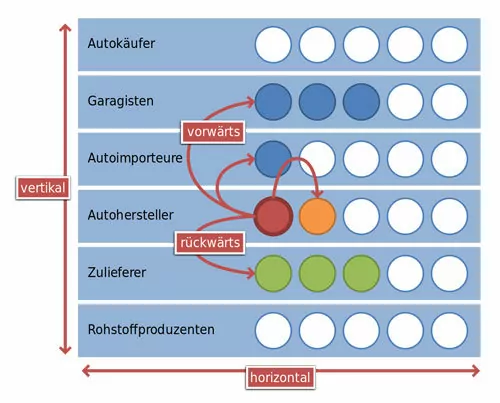Vertical integration stands for retail companies that exert influence over various stages of the supply chain. The close cooperation between industry and retail is the main focus. Brands, for example, often present themselves via so-called shop-in-shop concepts. Retailers, on the other hand, no longer appear exclusively in the classic sales segment, they also have production carried out. The fashion, consumer electronics, and automotive industries can stand out in particular through floor space concepts and so-called mono-brand stores.
Teaser image description: In the foreground, you can see the Apple product line, presented as a shop-in-shop solution. In the background, you can still see the shop contours of the Saturn Group.
Vertical integration merges industry and retail. On the one hand, brands and manufacturers can present themselves directly at the point of sale with so-called space concepts. On the other hand, with vertical integration, retailers can have goods produced or to deliver them themselves. The latter is a widespread concept, especially for mono-brand stores. The extent of the influence on the individual stages of the supply chain varies from company to company. One company controls more production, while another concentrates more on delivery or sales area.
Important: For vertical integration, the fewer processes a company transfers to external companies, the higher the degree of integration – the highest and best possible degree begins, similar to the lot size, with the value 1: integration degree 1 = high vertical integration.
On the other hand, there is horizontal integration: It stands for the consolidation (fusion) of companies that are similar in industry.
Vertical integration concepts common for brands and manufacturers
Corner concept: Large retail chains such as Saturn, MediaMarkt, and Karstadt are increasingly offering brands and manufacturers vertical cooperation in various forms. The simplest and smallest form describes a sales line within a store of less than 40 square meters. It is designed independently by the brand or manufacturer, adapted to the existing interior, and regularly stocked with the latest products.
Shop-in-shop concept: If the sales line takes on larger dimensions, one speaks of the shop-in-shop concept. Apple (see teaser picture), Samsung, Sony and Microsoft regularly offer their product range at Saturn or MediaMarkt, for example, on a designated sales area – usually with their own specialist staff. In the shop-in-shop concept, separate shop fitting elements are also used to show the customer the demarcations from the usual departments. It should be noted that the respective supplier presents and sells only a specific product range. A certain exclusivity is created. The brand and manufacturer enter into a binding contract with the retailer, which regulates the assortment, delivery and share of sales within the store.
Concession concept: In this concept, the retailer merely acts as the landlord. He rents a space directly to the manufacturer or brand. Usually, the retailer provides his own furniture and personnel. Possible variant: The retailer assumes responsibility for the store as the store manager.
Franchising: In the so-called concession sale, the concession holder grants the so-called concessionaire (tied retailer) a license. He is allowed to use the name, trademarks, equipment, and other property rights of the concessionaire in return for payment. He must use the sales strategies developed by the franchisor himself, including the sales system. The tied retailer is also supplied with goods by the proprietor and trained in the products and their handling.
Special case: Retailer is both designer and producer
Vertical integration has become particularly prevalent in the clothing industry. Labels such as Zara and H&M control the entire supply chain, from design, production, and logistics to sales to the end customer. The advantage: Both brands act as mono-brand stores and thus receive the entire profit from sales. They have an influence on the costs of production and delivery. Usually, the retail chains also offer exclusive design collections, for example by Karl Lagerfeld (H&M).
Vertical integration in the automotive industry
Vertical integration can also be observed in the automotive industry. Specialist dealers on behalf of VW and Mercedes are dependent on generating income through additional business (service and maintenance). One reason for services (after-sales) is the low margins from actual car sales. The advantage: They automatically bind both private and business customers with high service quality.

You can find further information on the retail sector in the article Stationary trade as well as in the article Integration of stationary trade in the value chain of e-commerce.
Teaser picture: Media-Saturn-Group / CC BY-ND 2.0
Picture Car Industry: Martin Sauter / CC BY-SA 3.0
Also available in Deutsch (German)